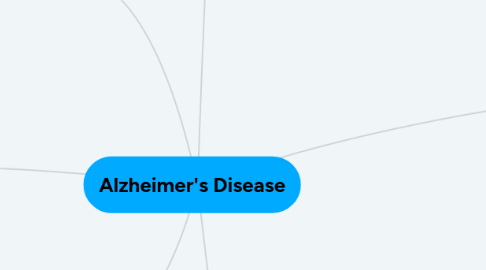
1. depression
2. Pathophysiology
2.1. incurable dementia
2.1.1. progressive chronic neurodegenerative condition
2.2. cognitive dysfuntion
2.3. neuritic plaque formation
2.4. neurofibrillary tangles in neurons
2.5. cholinergic neurotransmitter abnormality
3. Symptoms
3.1. memory loss
3.2. unable to communicate
3.3. aggressive behavior
3.4. psychoses
3.5. confusion
3.6. wandering
3.6.1. personality changes
3.7. hostility
3.8. paranoia
4. seizures
5. Treatments
5.1. goal:
5.1.1. reverse cognitive decline
5.1.2. improve symptoms
5.2. No available drugs to meet goals
5.3. Drugs approved but not very effective
5.3.1. Cholinesterase inhibitors
5.3.1.1. Action
5.3.1.1.1. allows more ACh in neuron receptors
5.3.1.1.2. increases cognitive function
5.3.1.2. Use
5.3.1.2.1. mild to mod Alzheimer's Diesease
5.3.1.3. donepezil (aricept)
5.3.1.4. galantamin (razadyne)
5.3.1.5. rivastigmine (exelon)
5.3.1.5.1. AChE inhibitor
5.3.1.5.2. slows disease process
5.3.1.5.3. abdominal pain
5.3.1.5.4. side effects:
5.3.1.5.5. adverse rxns:
5.3.1.6. tacrine (cognex)
5.3.2. MOA: modulates glutamate, believed to play critical role in learning and memory
5.3.3. mematine (namenda)
5.3.4. NMDA receptor antagonist
5.3.4.1. Uses: mod to severe Azheimer's
5.3.4.2. Adverse effects:
5.3.4.2.1. dizziness
5.3.4.2.2. headache
5.3.4.2.3. confusion
5.3.4.2.4. constipation
6. Neuropsychiatric Symptoms
6.1. experienced by 80% of pt
6.2. agitation, aggression, delusion, hallucinations
6.3. treated w:
6.3.1. antipsychotics
6.3.1.1. atypical anti psychotics , that seem to be most helpful
6.3.1.1.1. Risperidone
6.3.1.1.2. Olanzapine
6.3.2. cholinesterase inhibitors
6.3.3. mood stabilizers
6.3.4. anxiolytics
6.3.5. NMDA receptor antagonists
6.3.6. antidepressants

